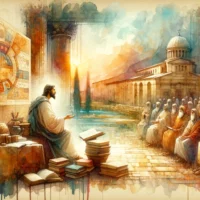The Gospels of Matthew, Mark, and Luke, commonly referred to as the Synoptic Gospels, display a significant degree of similarity that has intrigued scholars and theologians alike. These parallels pose a query famously known as the Synoptic problem – an investigation into the literary relationship between these Gospels. As we venture into this biblical exploration, it is our sincere hope that you, as a reader, will gain a deeper understanding and an enriched perspective of the sacred text.
Understanding the Synoptic Gospels
Let’s begin our exploration by defining the Synoptic Gospels. Matthew, Mark, and Luke form this triad, aptly named because they can be “seen together.” This is owing to their striking resemblance, both in the content they contain and the order in which it’s presented.
Mark’s Gospel is the briefest, primarily dealing with Jesus’ actions. It provides vibrant portrayals of Jesus’ ministry, from the stirring words of John the Baptist to the Passion, the Crucifixion, and the enigmatic ending at the empty tomb. It’s widely accepted among scholars that Mark was the first Gospel written (Mark 1:1-16:8).
Matthew’s Gospel, while drawing on similar events, lays a particular emphasis on Jesus’ teachings, featuring numerous parables and the famed Sermon on the Mount. Matthew’s version of the life of Christ, from his miraculous birth to his Resurrection, aims to demonstrate Jesus as the promised Messiah, weaving a narrative that fulfils Old Testament prophecies (Matthew 1:1-28:20).
Luke’s Gospel presents a comprehensive portrait of Jesus, blending a rich narrative of his life with significant emphasis on his teachings and compassion towards the downtrodden and marginalized. Luke uniquely begins with a detailed account of Jesus’ birth and early life, featuring characters like Elizabeth and Zechariah, and events such as the Annunciation and the Visitation. Luke follows Jesus’ journey all the way to Jerusalem, culminating in the Passion and Resurrection narratives (Luke 1:1-24:53).
While each of these Gospels is unique in its focus and style, they collectively recount similar stories of Jesus’ life, often with verbatim wording. This includes, for instance, the calling of the first disciples, the parable of the sower, the feeding of the five thousand, and the passion narrative. At the same time, they also bear distinctive elements exclusive to each, reflecting the unique perspective and purpose of the individual authors.
The Synoptic Gospels thus serve to provide a multifaceted account of Jesus’ life and ministry, highlighting his miracles, teachings, and his sacrificial death and resurrection. While they bear resemblances, each contributes to a richer, more complex image of Jesus Christ, the Savior of mankind.
The Synoptic Gospels – Matthew, Mark, and Luke – display significant similarities in the narrative of Jesus’ life, from his ministry to his resurrection. Mark, believed to be the first written, focuses on Jesus’ actions. Matthew emphasizes Jesus as the Messiah and features an extensive collection of his teachings. Luke presents a comprehensive account of Jesus’ life, highlighting his compassion towards the marginalized. Although they share similar stories often in the same order, each Gospel retains unique elements, contributing to a more complete understanding of the life and teachings of Jesus.
Theories Explaining the Synoptic Problem
The Synoptic problem arises from the task of explaining the textual similarities and differences among the three Synoptic Gospels. In seeking answers, various theories have emerged.
One of the oldest and most widely accepted theories is the Two-Source Hypothesis. This theory suggests that Mark’s Gospel was the first written, which was then used as a source by both Matthew and Luke. Additionally, it proposes the existence of a hypothetical document known as ‘Q’ (from the German word ‘Quelle’, meaning ‘source’). This Q document, which hasn’t been discovered but is deduced from the analysis of text, is believed to have contained sayings of Jesus that Matthew and Luke used, but which are not present in Mark.
Another theory is the Farrer Hypothesis, which discards the idea of a Q document. According to this theory, Mark still wrote first, but it was Matthew who used Mark as a source. Luke then used both Mark and Matthew as his sources, explaining the content common to all three and the material common only to Matthew and Luke.
The Griesbach Hypothesis (also known as the Two-Gospel Hypothesis) suggests a different order of writing. In this scenario, Matthew is seen as the first Gospel written, followed by Luke, who used Matthew as a source. Mark then used both Matthew and Luke, condensing their material, which explains why Mark is shorter and why it contains almost nothing that isn’t found in either Matthew or Luke.
These theories all try to address the Synoptic problem by discerning the literary relationships among the Gospels. Each provides a possible explanation for the shared content and for the unique passages in each Gospel, adding another layer of understanding to our reading and interpretation of these sacred texts.
The Synoptic problem refers to the textual similarities and differences among the three Synoptic Gospels. Several theories have been proposed to explain these, including the Two-Source Hypothesis, which posits that Mark was the first Gospel, and that Matthew and Luke used Mark and a hypothetical Q document as sources. The Farrer Hypothesis suggests that Matthew and Luke used Mark, but without a Q document. The Griesbach Hypothesis proposes that Matthew was first, used by Luke, and then both were used by Mark. Each theory offers a possible explanation for the shared and unique content found in the Synoptic Gospels.
Implications of the Synoptic Problem for Faith and Practice
Understanding the Synoptic problem can significantly enhance our approach to reading and interpreting the Gospels. It brings to the fore the fact that the Gospels were products of specific historical and cultural contexts, penned by different authors who had distinct perspectives and purposes.
One might think that variations in the Gospels would challenge the integrity of the Bible, but that’s not the case. Instead, it underlines the rich diversity of the early Christian experiences and perspectives. Just as a gem has many facets, the story of Jesus’ life, ministry, death, and resurrection is multifaceted, and these diverse accounts of the same events offer us a more comprehensive and robust understanding of the person and work of Jesus Christ.
The exploration of the Synoptic problem allows us to approach Scripture with humility and reverence. The Gospels, like the rest of the Bible, require careful and prayerful interpretation. We’re reminded to be mindful of the intended audience, the author’s perspective, and the context in which each Gospel was written. This nuanced reading can deepen our understanding of Jesus’ teachings and help us apply these lessons in our daily lives.
The Synoptic problem also emphasizes the communal nature of the biblical canon. The Gospels didn’t arise in a vacuum but in a vibrant community of faith, which treasured these accounts and passed them on for the benefit of future generations. This sense of Christian community rooted in the shared memories of Jesus’ life and teachings strengthens our communal bonds and reinforces our shared faith.
This exploration may lead to a strengthened faith, a more reflective reading of Scripture, and a deeper understanding of our shared Christian heritage. The Synoptic problem is, thus, not a problem per se but an invitation to engage more deeply with the sacred text.
The Synoptic problem is an invitation to enhance our understanding of the Gospels. Recognizing that the Gospels were written in specific historical and cultural contexts allows for a richer, more nuanced understanding of the events and teachings they chronicle. These variations don’t challenge the integrity of the Bible but underscore the diversity of early Christian experiences. The careful examination of the Synoptic problem can deepen our understanding of the Gospels, leading to a more reflective reading and practical application of Jesus’ teachings. It emphasizes the communal nature of the biblical canon and serves to strengthen our shared Christian faith.
The Gospel Tapestry: Woven in Faith
The Synoptic problem serves as a reminder of the dynamic nature of Scripture. It brings to light the historical, cultural, and communal contexts within which the Gospels of Matthew, Mark, and Luke were written. Far from being a problem, the similarities and differences between these accounts present an opportunity for us to appreciate the multifaceted nature of Jesus’ life and teachings.
Reflect on these questions:
- How might understanding the Synoptic problem change your approach to reading the Gospels?
- What might the unique perspectives in each Gospel reveal about the early Christian communities?
- How could the exploration of the Synoptic problem deepen your personal Christian faith?
In the rich tapestry of the Gospels, each thread contributes to a more complete depiction of Jesus Christ, the Savior of humanity. May this understanding foster a more profound connection with the text and inspire you to live out your faith with renewed vigor and commitment.














